HLSC122 Assessment 3: Critical Analysis of Drug Use Research Findings
VerifiedAdded on 2022/11/01
|8
|1839
|280
Report
AI Summary
This report critically analyzes a research article by Day et al. (2018) investigating illicit drug use, knowledge, and practices among music festival attendees. The study, conducted at an Australian music festival, surveyed 642 participants aged 18-30, revealing high rates of illicit drug use, particularly cannabis and ecstasy. The report appraises the research methodology, findings, and limitations, including potential gender biases. It then applies these findings to a case study involving Emily, whose mother is concerned about drug testing at a music festival. The report discusses enablers and barriers to implementing the research findings, such as the large sample size versus the non-consideration of intoxicated participants, and concludes by emphasizing the need for further research to inform effective intervention strategies and harm reduction practices. The report also references the importance of considering qualitative perceptions and biases in research methodology.
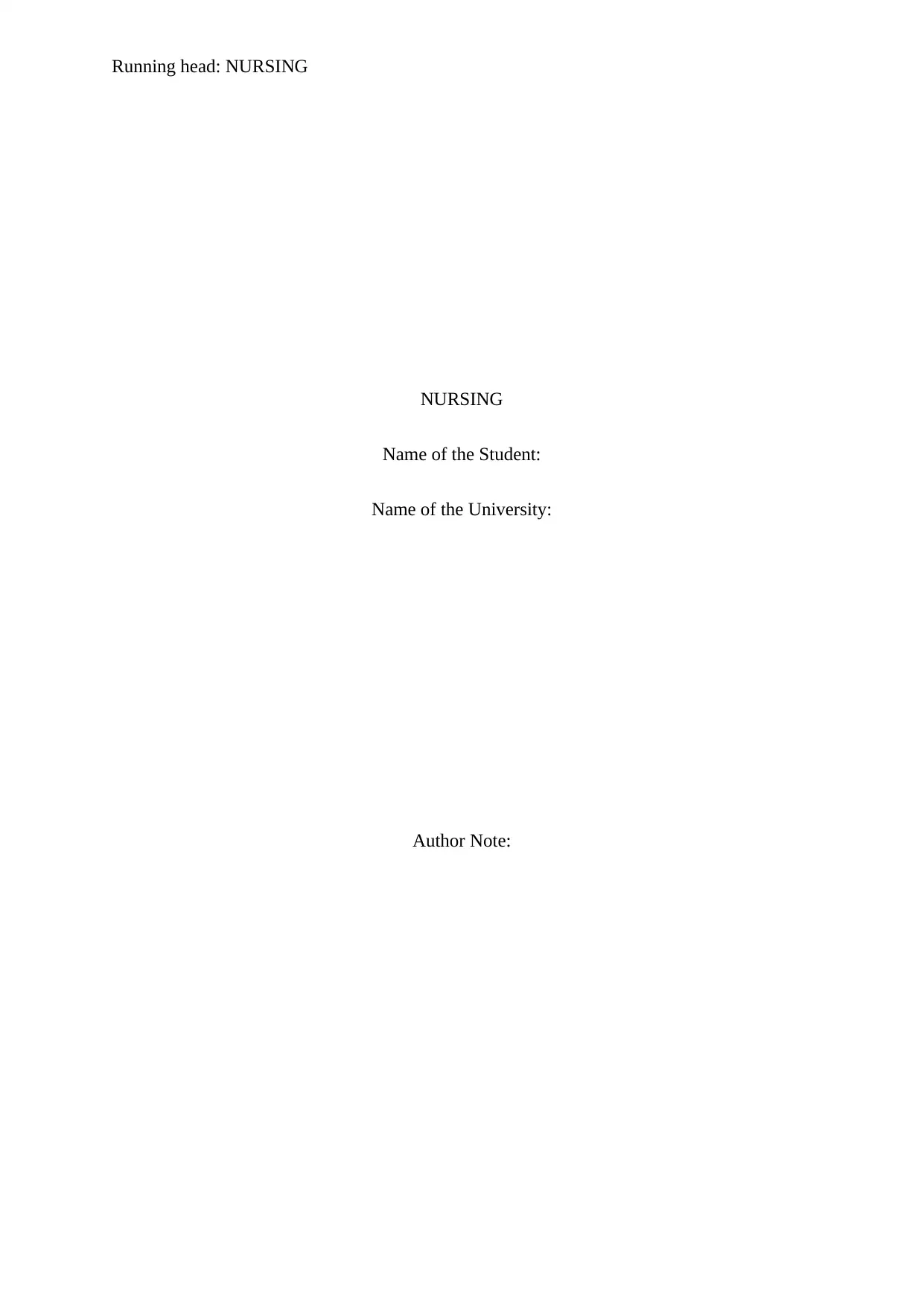
Running head: NURSING
NURSING
Name of the Student:
Name of the University:
Author Note:
NURSING
Name of the Student:
Name of the University:
Author Note:
Paraphrase This Document
Need a fresh take? Get an instant paraphrase of this document with our AI Paraphraser
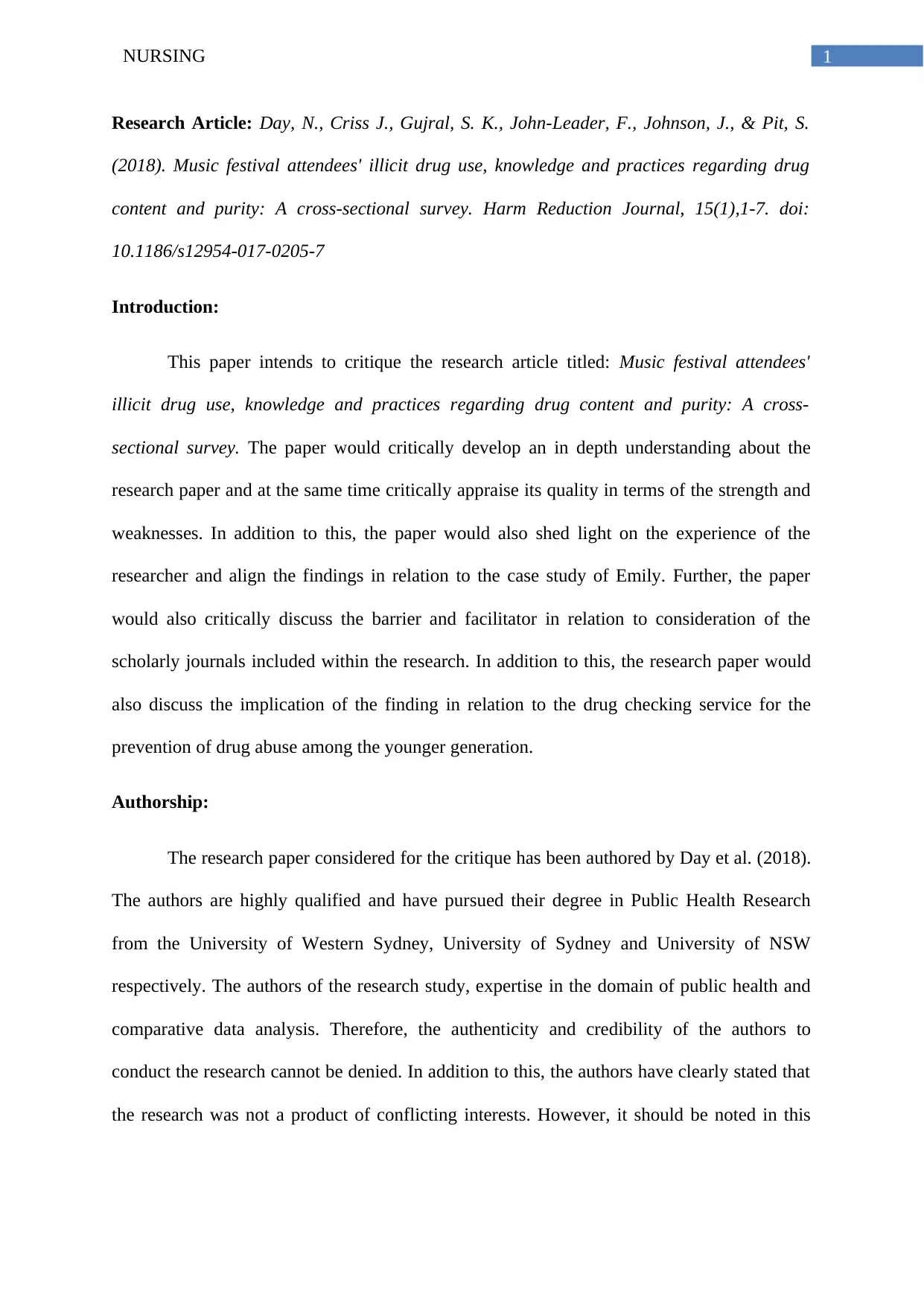
1NURSING
Research Article: Day, N., Criss J., Gujral, S. K., John-Leader, F., Johnson, J., & Pit, S.
(2018). Music festival attendees' illicit drug use, knowledge and practices regarding drug
content and purity: A cross-sectional survey. Harm Reduction Journal, 15(1),1-7. doi:
10.1186/s12954-017-0205-7
Introduction:
This paper intends to critique the research article titled: Music festival attendees'
illicit drug use, knowledge and practices regarding drug content and purity: A cross-
sectional survey. The paper would critically develop an in depth understanding about the
research paper and at the same time critically appraise its quality in terms of the strength and
weaknesses. In addition to this, the paper would also shed light on the experience of the
researcher and align the findings in relation to the case study of Emily. Further, the paper
would also critically discuss the barrier and facilitator in relation to consideration of the
scholarly journals included within the research. In addition to this, the research paper would
also discuss the implication of the finding in relation to the drug checking service for the
prevention of drug abuse among the younger generation.
Authorship:
The research paper considered for the critique has been authored by Day et al. (2018).
The authors are highly qualified and have pursued their degree in Public Health Research
from the University of Western Sydney, University of Sydney and University of NSW
respectively. The authors of the research study, expertise in the domain of public health and
comparative data analysis. Therefore, the authenticity and credibility of the authors to
conduct the research cannot be denied. In addition to this, the authors have clearly stated that
the research was not a product of conflicting interests. However, it should be noted in this
Research Article: Day, N., Criss J., Gujral, S. K., John-Leader, F., Johnson, J., & Pit, S.
(2018). Music festival attendees' illicit drug use, knowledge and practices regarding drug
content and purity: A cross-sectional survey. Harm Reduction Journal, 15(1),1-7. doi:
10.1186/s12954-017-0205-7
Introduction:
This paper intends to critique the research article titled: Music festival attendees'
illicit drug use, knowledge and practices regarding drug content and purity: A cross-
sectional survey. The paper would critically develop an in depth understanding about the
research paper and at the same time critically appraise its quality in terms of the strength and
weaknesses. In addition to this, the paper would also shed light on the experience of the
researcher and align the findings in relation to the case study of Emily. Further, the paper
would also critically discuss the barrier and facilitator in relation to consideration of the
scholarly journals included within the research. In addition to this, the research paper would
also discuss the implication of the finding in relation to the drug checking service for the
prevention of drug abuse among the younger generation.
Authorship:
The research paper considered for the critique has been authored by Day et al. (2018).
The authors are highly qualified and have pursued their degree in Public Health Research
from the University of Western Sydney, University of Sydney and University of NSW
respectively. The authors of the research study, expertise in the domain of public health and
comparative data analysis. Therefore, the authenticity and credibility of the authors to
conduct the research cannot be denied. In addition to this, the authors have clearly stated that
the research was not a product of conflicting interests. However, it should be noted in this
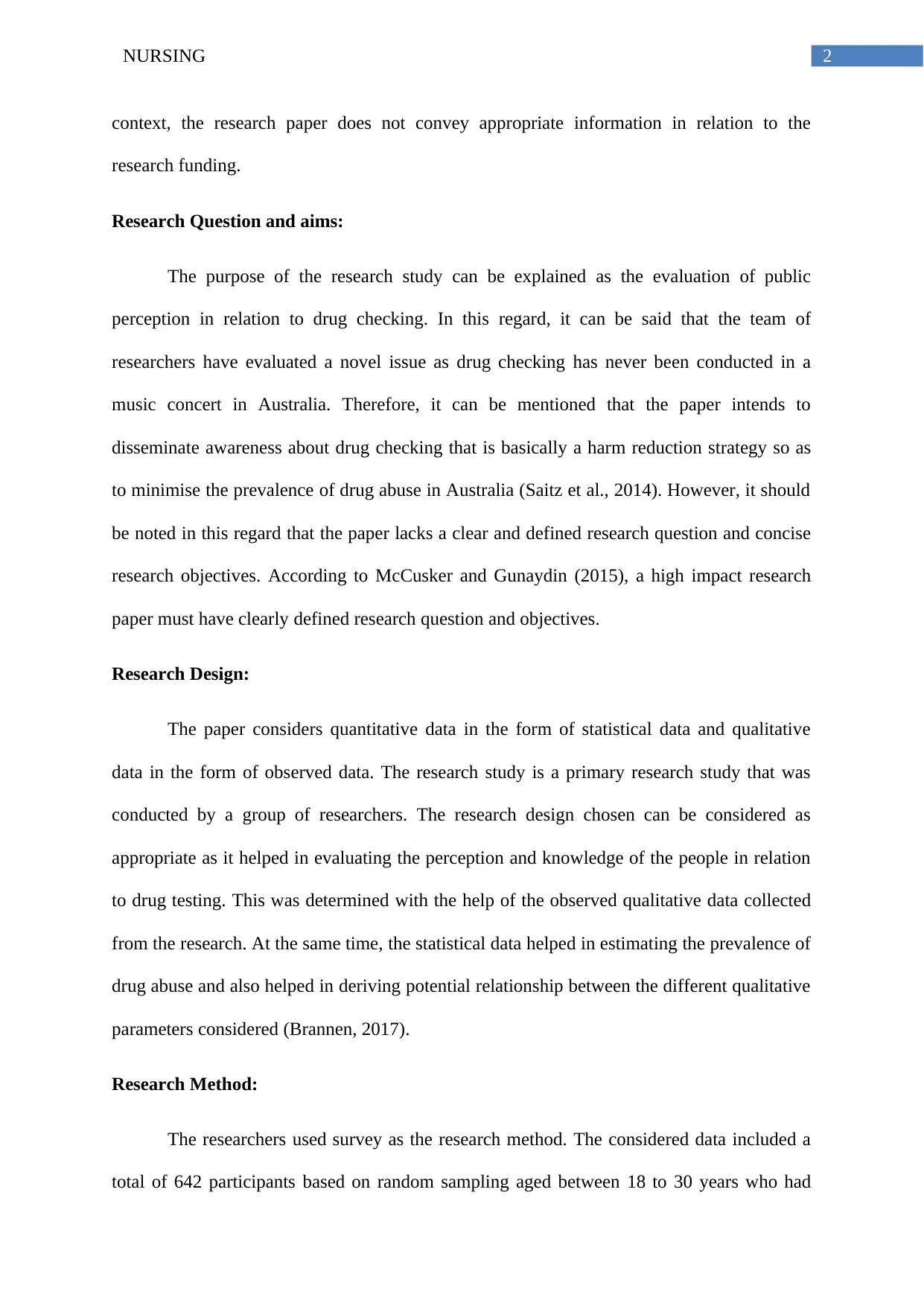
2NURSING
context, the research paper does not convey appropriate information in relation to the
research funding.
Research Question and aims:
The purpose of the research study can be explained as the evaluation of public
perception in relation to drug checking. In this regard, it can be said that the team of
researchers have evaluated a novel issue as drug checking has never been conducted in a
music concert in Australia. Therefore, it can be mentioned that the paper intends to
disseminate awareness about drug checking that is basically a harm reduction strategy so as
to minimise the prevalence of drug abuse in Australia (Saitz et al., 2014). However, it should
be noted in this regard that the paper lacks a clear and defined research question and concise
research objectives. According to McCusker and Gunaydin (2015), a high impact research
paper must have clearly defined research question and objectives.
Research Design:
The paper considers quantitative data in the form of statistical data and qualitative
data in the form of observed data. The research study is a primary research study that was
conducted by a group of researchers. The research design chosen can be considered as
appropriate as it helped in evaluating the perception and knowledge of the people in relation
to drug testing. This was determined with the help of the observed qualitative data collected
from the research. At the same time, the statistical data helped in estimating the prevalence of
drug abuse and also helped in deriving potential relationship between the different qualitative
parameters considered (Brannen, 2017).
Research Method:
The researchers used survey as the research method. The considered data included a
total of 642 participants based on random sampling aged between 18 to 30 years who had
context, the research paper does not convey appropriate information in relation to the
research funding.
Research Question and aims:
The purpose of the research study can be explained as the evaluation of public
perception in relation to drug checking. In this regard, it can be said that the team of
researchers have evaluated a novel issue as drug checking has never been conducted in a
music concert in Australia. Therefore, it can be mentioned that the paper intends to
disseminate awareness about drug checking that is basically a harm reduction strategy so as
to minimise the prevalence of drug abuse in Australia (Saitz et al., 2014). However, it should
be noted in this regard that the paper lacks a clear and defined research question and concise
research objectives. According to McCusker and Gunaydin (2015), a high impact research
paper must have clearly defined research question and objectives.
Research Design:
The paper considers quantitative data in the form of statistical data and qualitative
data in the form of observed data. The research study is a primary research study that was
conducted by a group of researchers. The research design chosen can be considered as
appropriate as it helped in evaluating the perception and knowledge of the people in relation
to drug testing. This was determined with the help of the observed qualitative data collected
from the research. At the same time, the statistical data helped in estimating the prevalence of
drug abuse and also helped in deriving potential relationship between the different qualitative
parameters considered (Brannen, 2017).
Research Method:
The researchers used survey as the research method. The considered data included a
total of 642 participants based on random sampling aged between 18 to 30 years who had
⊘ This is a preview!⊘
Do you want full access?
Subscribe today to unlock all pages.

Trusted by 1+ million students worldwide
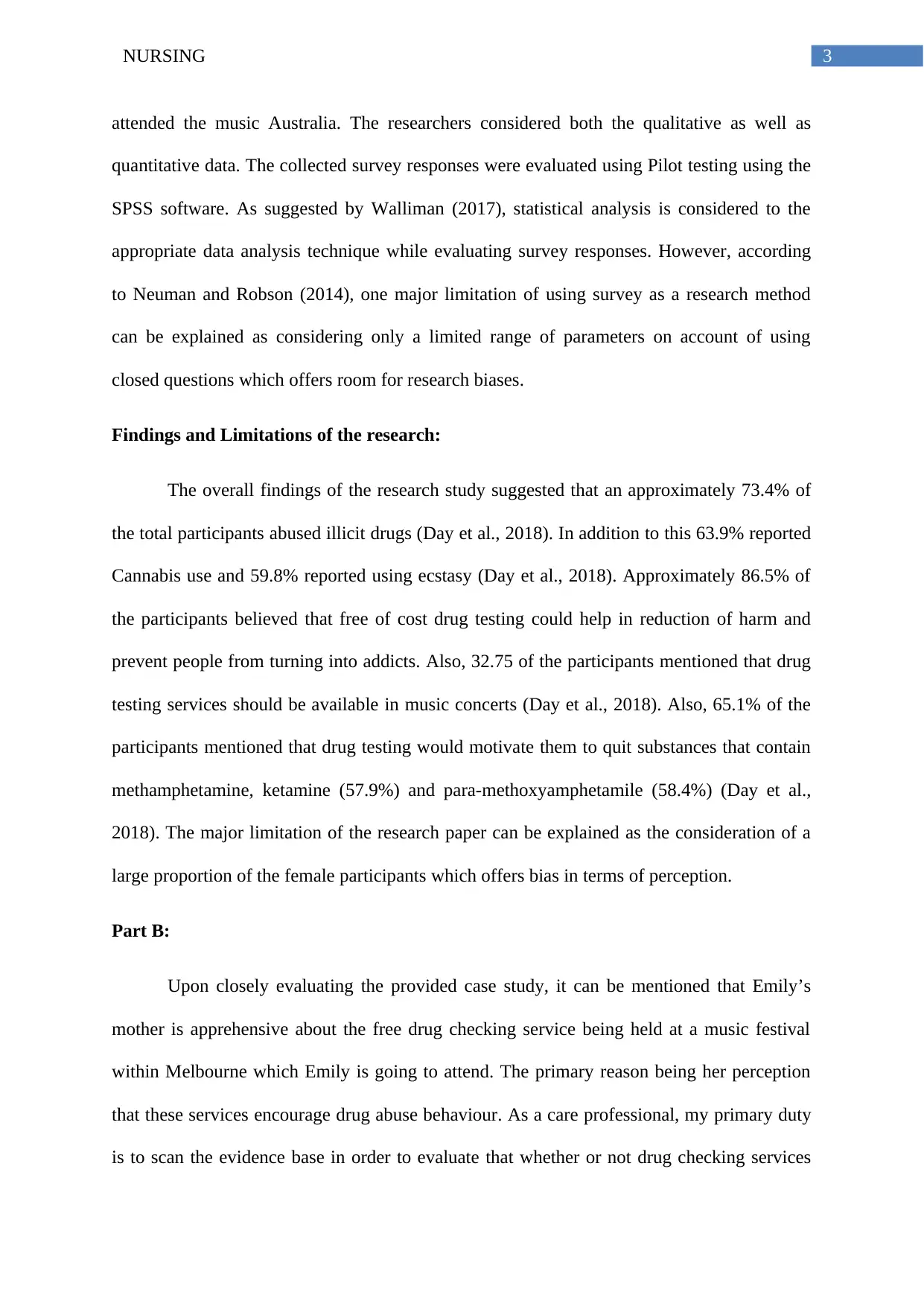
3NURSING
attended the music Australia. The researchers considered both the qualitative as well as
quantitative data. The collected survey responses were evaluated using Pilot testing using the
SPSS software. As suggested by Walliman (2017), statistical analysis is considered to the
appropriate data analysis technique while evaluating survey responses. However, according
to Neuman and Robson (2014), one major limitation of using survey as a research method
can be explained as considering only a limited range of parameters on account of using
closed questions which offers room for research biases.
Findings and Limitations of the research:
The overall findings of the research study suggested that an approximately 73.4% of
the total participants abused illicit drugs (Day et al., 2018). In addition to this 63.9% reported
Cannabis use and 59.8% reported using ecstasy (Day et al., 2018). Approximately 86.5% of
the participants believed that free of cost drug testing could help in reduction of harm and
prevent people from turning into addicts. Also, 32.75 of the participants mentioned that drug
testing services should be available in music concerts (Day et al., 2018). Also, 65.1% of the
participants mentioned that drug testing would motivate them to quit substances that contain
methamphetamine, ketamine (57.9%) and para-methoxyamphetamile (58.4%) (Day et al.,
2018). The major limitation of the research paper can be explained as the consideration of a
large proportion of the female participants which offers bias in terms of perception.
Part B:
Upon closely evaluating the provided case study, it can be mentioned that Emily’s
mother is apprehensive about the free drug checking service being held at a music festival
within Melbourne which Emily is going to attend. The primary reason being her perception
that these services encourage drug abuse behaviour. As a care professional, my primary duty
is to scan the evidence base in order to evaluate that whether or not drug checking services
attended the music Australia. The researchers considered both the qualitative as well as
quantitative data. The collected survey responses were evaluated using Pilot testing using the
SPSS software. As suggested by Walliman (2017), statistical analysis is considered to the
appropriate data analysis technique while evaluating survey responses. However, according
to Neuman and Robson (2014), one major limitation of using survey as a research method
can be explained as considering only a limited range of parameters on account of using
closed questions which offers room for research biases.
Findings and Limitations of the research:
The overall findings of the research study suggested that an approximately 73.4% of
the total participants abused illicit drugs (Day et al., 2018). In addition to this 63.9% reported
Cannabis use and 59.8% reported using ecstasy (Day et al., 2018). Approximately 86.5% of
the participants believed that free of cost drug testing could help in reduction of harm and
prevent people from turning into addicts. Also, 32.75 of the participants mentioned that drug
testing services should be available in music concerts (Day et al., 2018). Also, 65.1% of the
participants mentioned that drug testing would motivate them to quit substances that contain
methamphetamine, ketamine (57.9%) and para-methoxyamphetamile (58.4%) (Day et al.,
2018). The major limitation of the research paper can be explained as the consideration of a
large proportion of the female participants which offers bias in terms of perception.
Part B:
Upon closely evaluating the provided case study, it can be mentioned that Emily’s
mother is apprehensive about the free drug checking service being held at a music festival
within Melbourne which Emily is going to attend. The primary reason being her perception
that these services encourage drug abuse behaviour. As a care professional, my primary duty
is to scan the evidence base in order to evaluate that whether or not drug checking services
Paraphrase This Document
Need a fresh take? Get an instant paraphrase of this document with our AI Paraphraser
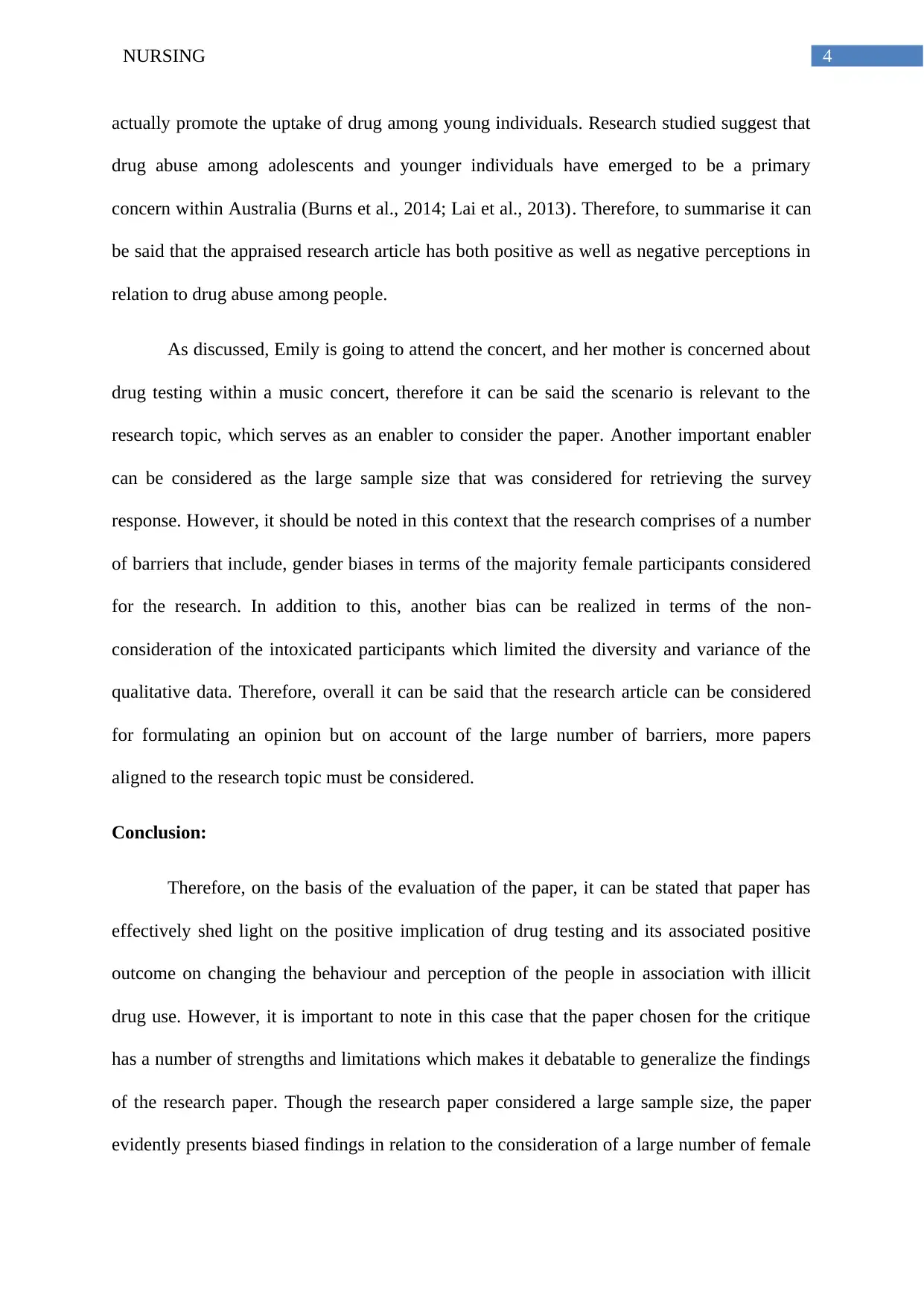
4NURSING
actually promote the uptake of drug among young individuals. Research studied suggest that
drug abuse among adolescents and younger individuals have emerged to be a primary
concern within Australia (Burns et al., 2014; Lai et al., 2013). Therefore, to summarise it can
be said that the appraised research article has both positive as well as negative perceptions in
relation to drug abuse among people.
As discussed, Emily is going to attend the concert, and her mother is concerned about
drug testing within a music concert, therefore it can be said the scenario is relevant to the
research topic, which serves as an enabler to consider the paper. Another important enabler
can be considered as the large sample size that was considered for retrieving the survey
response. However, it should be noted in this context that the research comprises of a number
of barriers that include, gender biases in terms of the majority female participants considered
for the research. In addition to this, another bias can be realized in terms of the non-
consideration of the intoxicated participants which limited the diversity and variance of the
qualitative data. Therefore, overall it can be said that the research article can be considered
for formulating an opinion but on account of the large number of barriers, more papers
aligned to the research topic must be considered.
Conclusion:
Therefore, on the basis of the evaluation of the paper, it can be stated that paper has
effectively shed light on the positive implication of drug testing and its associated positive
outcome on changing the behaviour and perception of the people in association with illicit
drug use. However, it is important to note in this case that the paper chosen for the critique
has a number of strengths and limitations which makes it debatable to generalize the findings
of the research paper. Though the research paper considered a large sample size, the paper
evidently presents biased findings in relation to the consideration of a large number of female
actually promote the uptake of drug among young individuals. Research studied suggest that
drug abuse among adolescents and younger individuals have emerged to be a primary
concern within Australia (Burns et al., 2014; Lai et al., 2013). Therefore, to summarise it can
be said that the appraised research article has both positive as well as negative perceptions in
relation to drug abuse among people.
As discussed, Emily is going to attend the concert, and her mother is concerned about
drug testing within a music concert, therefore it can be said the scenario is relevant to the
research topic, which serves as an enabler to consider the paper. Another important enabler
can be considered as the large sample size that was considered for retrieving the survey
response. However, it should be noted in this context that the research comprises of a number
of barriers that include, gender biases in terms of the majority female participants considered
for the research. In addition to this, another bias can be realized in terms of the non-
consideration of the intoxicated participants which limited the diversity and variance of the
qualitative data. Therefore, overall it can be said that the research article can be considered
for formulating an opinion but on account of the large number of barriers, more papers
aligned to the research topic must be considered.
Conclusion:
Therefore, on the basis of the evaluation of the paper, it can be stated that paper has
effectively shed light on the positive implication of drug testing and its associated positive
outcome on changing the behaviour and perception of the people in association with illicit
drug use. However, it is important to note in this case that the paper chosen for the critique
has a number of strengths and limitations which makes it debatable to generalize the findings
of the research paper. Though the research paper considered a large sample size, the paper
evidently presents biased findings in relation to the consideration of a large number of female
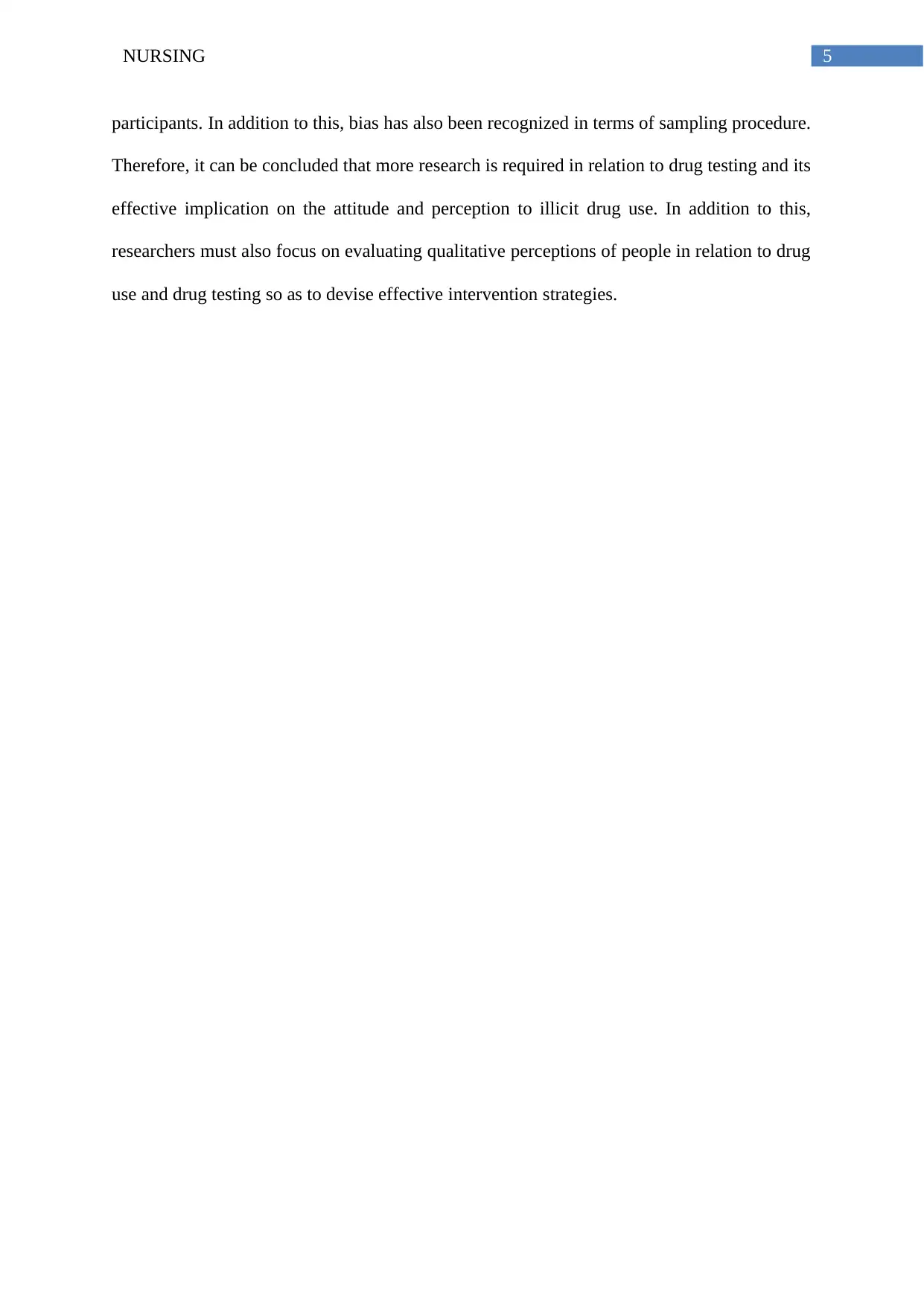
5NURSING
participants. In addition to this, bias has also been recognized in terms of sampling procedure.
Therefore, it can be concluded that more research is required in relation to drug testing and its
effective implication on the attitude and perception to illicit drug use. In addition to this,
researchers must also focus on evaluating qualitative perceptions of people in relation to drug
use and drug testing so as to devise effective intervention strategies.
participants. In addition to this, bias has also been recognized in terms of sampling procedure.
Therefore, it can be concluded that more research is required in relation to drug testing and its
effective implication on the attitude and perception to illicit drug use. In addition to this,
researchers must also focus on evaluating qualitative perceptions of people in relation to drug
use and drug testing so as to devise effective intervention strategies.
⊘ This is a preview!⊘
Do you want full access?
Subscribe today to unlock all pages.

Trusted by 1+ million students worldwide
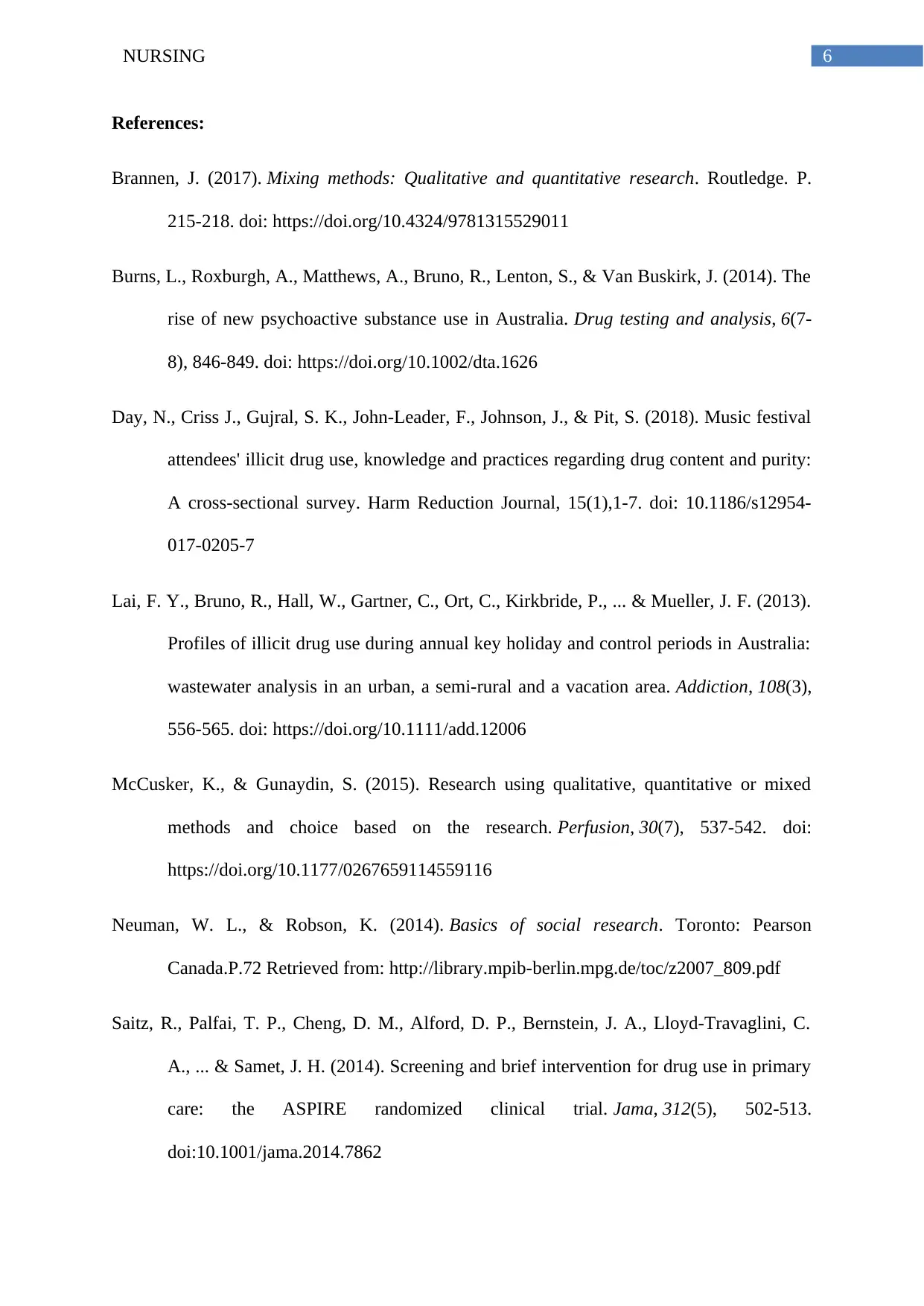
6NURSING
References:
Brannen, J. (2017). Mixing methods: Qualitative and quantitative research. Routledge. P.
215-218. doi: https://doi.org/10.4324/9781315529011
Burns, L., Roxburgh, A., Matthews, A., Bruno, R., Lenton, S., & Van Buskirk, J. (2014). The
rise of new psychoactive substance use in Australia. Drug testing and analysis, 6(7-
8), 846-849. doi: https://doi.org/10.1002/dta.1626
Day, N., Criss J., Gujral, S. K., John-Leader, F., Johnson, J., & Pit, S. (2018). Music festival
attendees' illicit drug use, knowledge and practices regarding drug content and purity:
A cross-sectional survey. Harm Reduction Journal, 15(1),1-7. doi: 10.1186/s12954-
017-0205-7
Lai, F. Y., Bruno, R., Hall, W., Gartner, C., Ort, C., Kirkbride, P., ... & Mueller, J. F. (2013).
Profiles of illicit drug use during annual key holiday and control periods in Australia:
wastewater analysis in an urban, a semi‐rural and a vacation area. Addiction, 108(3),
556-565. doi: https://doi.org/10.1111/add.12006
McCusker, K., & Gunaydin, S. (2015). Research using qualitative, quantitative or mixed
methods and choice based on the research. Perfusion, 30(7), 537-542. doi:
https://doi.org/10.1177/0267659114559116
Neuman, W. L., & Robson, K. (2014). Basics of social research. Toronto: Pearson
Canada.P.72 Retrieved from: http://library.mpib-berlin.mpg.de/toc/z2007_809.pdf
Saitz, R., Palfai, T. P., Cheng, D. M., Alford, D. P., Bernstein, J. A., Lloyd-Travaglini, C.
A., ... & Samet, J. H. (2014). Screening and brief intervention for drug use in primary
care: the ASPIRE randomized clinical trial. Jama, 312(5), 502-513.
doi:10.1001/jama.2014.7862
References:
Brannen, J. (2017). Mixing methods: Qualitative and quantitative research. Routledge. P.
215-218. doi: https://doi.org/10.4324/9781315529011
Burns, L., Roxburgh, A., Matthews, A., Bruno, R., Lenton, S., & Van Buskirk, J. (2014). The
rise of new psychoactive substance use in Australia. Drug testing and analysis, 6(7-
8), 846-849. doi: https://doi.org/10.1002/dta.1626
Day, N., Criss J., Gujral, S. K., John-Leader, F., Johnson, J., & Pit, S. (2018). Music festival
attendees' illicit drug use, knowledge and practices regarding drug content and purity:
A cross-sectional survey. Harm Reduction Journal, 15(1),1-7. doi: 10.1186/s12954-
017-0205-7
Lai, F. Y., Bruno, R., Hall, W., Gartner, C., Ort, C., Kirkbride, P., ... & Mueller, J. F. (2013).
Profiles of illicit drug use during annual key holiday and control periods in Australia:
wastewater analysis in an urban, a semi‐rural and a vacation area. Addiction, 108(3),
556-565. doi: https://doi.org/10.1111/add.12006
McCusker, K., & Gunaydin, S. (2015). Research using qualitative, quantitative or mixed
methods and choice based on the research. Perfusion, 30(7), 537-542. doi:
https://doi.org/10.1177/0267659114559116
Neuman, W. L., & Robson, K. (2014). Basics of social research. Toronto: Pearson
Canada.P.72 Retrieved from: http://library.mpib-berlin.mpg.de/toc/z2007_809.pdf
Saitz, R., Palfai, T. P., Cheng, D. M., Alford, D. P., Bernstein, J. A., Lloyd-Travaglini, C.
A., ... & Samet, J. H. (2014). Screening and brief intervention for drug use in primary
care: the ASPIRE randomized clinical trial. Jama, 312(5), 502-513.
doi:10.1001/jama.2014.7862
Paraphrase This Document
Need a fresh take? Get an instant paraphrase of this document with our AI Paraphraser

7NURSING
Walliman, N. (2017). Research methods: The basics. Routledge.P.90
Walliman, N. (2017). Research methods: The basics. Routledge.P.90
1 out of 8
Related Documents
Your All-in-One AI-Powered Toolkit for Academic Success.
+13062052269
info@desklib.com
Available 24*7 on WhatsApp / Email
![[object Object]](/_next/static/media/star-bottom.7253800d.svg)
Unlock your academic potential
Copyright © 2020–2025 A2Z Services. All Rights Reserved. Developed and managed by ZUCOL.




